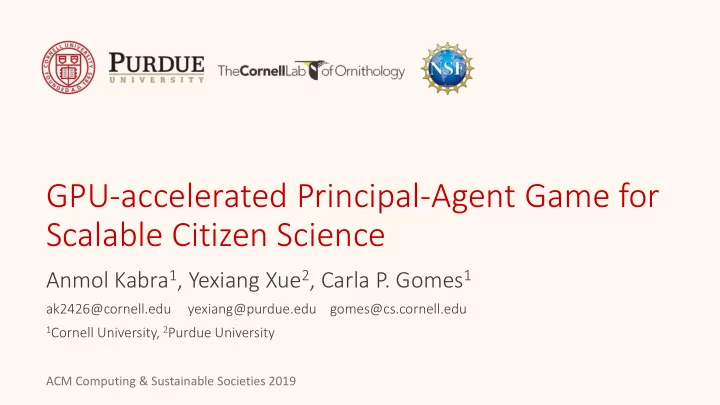

GPU-accelerated Principal-Agent Game for Scalable Citizen Science Anmol Kabra 1 , Yexiang Xue 2 , Carla P. Gomes 1 ak2426@cornell.edu yexiang@purdue.edu gomes@cs.cornell.edu 1 Cornell University, 2 Purdue University ACM Computing & Sustainable Societies 2019
Sampling Bias in Citizen Science • Crowdsourcing/Citizen Science programs ( eBird , Zooniverse , CoralWatch ) engage public in collecting data for research problems • Data used for policy making, environmental conservation etc. • Citizens’ motivations for tasks ➔ Sampling bias ➔ Spatial clustering Spatial clustering in Mainland and Midwest US in eBird before 2014 (Xue, 2016a)
Previous Approaches • Misaligned motivations of program (principal) and citizens (agent) • Avicaching : incentivize citizens to visit under-sampled locations • 20% shift in eBird submissions after Avicaching (Xue, 2016a)
Previous Approaches Incentives • A Principal-Agent game: model citizen behavior to distribute Self Interest Self Interest effective rewards Principal Agent • Two subproblems: • Identification: learn agent behavior • Pricing: redistribute rewards Data Collection • MIP solves pricing, identification embedded • 3 hours for ≈30 locations Deploy Rewards Learn Agents’ Behavior 𝑤 ∗ Identification Problem Redistribute Rewards 𝑠 ∗ Pricing Problem MIP = Mixed-Integer-Programming
Formalizing the Problem: Identification • For time period 𝑢 , 𝐲 𝐮 ∈ ℝ 𝑜 are visit densities of 𝑜 𝐐 𝐠,𝐬 𝐮 ;𝐱 locations before rewards 𝐬 𝐮 ∈ ℝ 𝑜 were placed; 𝐳 𝐮 are visit densities after placement • Goal: learn matrix 𝐐 s.t. 𝐐𝐲 𝐮 ≈ 𝐳 𝐮 • 𝐐 depends on features of locations 𝐠 , rewards 𝐬 𝐮 , with 𝑦 𝑢,1 𝑧 𝑢,1 parameters 𝐱 ⋮ ⋮ • 𝑞 𝑣,𝑤 = Pr( shift of submissions from location 𝑤 to 𝑣) 𝑦 𝑢,𝑜 𝑧 𝑢,𝑜 𝐱 ∗ = argmin Before 𝐬 𝐮 After 𝐬 𝐮 2 𝐳 𝐮 − 𝐐𝐲 𝐮 2 𝐱 𝑢
Formalizing the Problem: Pricing With 𝐱 ∗ learned from Identification 𝐐 𝐠,𝐬;𝐱 ∗ • Goal: distribute rewards s.t. future visit density is uniform • With 𝐲 = σ 𝑢 𝐲 𝐮 , reduce variance of 𝐳 = 𝐐 𝐠,𝐬;𝐱 ∗ 𝐲 1 𝐬 ∗ = argmin 𝑜 𝐳 − 𝐳 1 𝑦 𝑢,1 𝑧 𝑢,1 𝐬 • Constraints on 𝐬 : ⋮ ⋮ • Sum up to budget 𝑆 , i.e., 𝐬 1 ≤ 𝑆 𝑦 𝑢,𝑜 𝑧 𝑢,𝑜 • Non-negative, i.e., ∀ 𝑣, 𝑠 𝑣 ≥ 0 Before 𝐬 𝐮 After 𝐬 𝐮
Scaling up the Game with Machine Learning 𝐬 𝐮 1 Deploy rewards 𝐱 ∗ 2 𝐬 ∗ 3 𝑦 𝑢,1 𝑧 𝑢,1 𝐐 𝐠,𝐬 𝐮 ;𝐱 1 ⋮ ⋮ 𝐬 ∗ = argmin 𝑜 𝐳 − 𝐳 1 𝐬 𝑦 𝑢,𝑜 𝑧 𝑢,𝑜 Before 𝐬 𝐮 After 𝐬 𝐮 subject to: • 𝐳 = 𝐐 𝐠,𝐬; 𝐱 ∗ 𝐲 𝐱 ∗ = argmin • 𝐬 1 ≤ 𝑆 2 𝐳 𝐮 − 𝐐𝐲 𝐮 2 • ∀ 𝑣, 𝑠 𝑣 ≥ 0 𝐱 𝑢
Scaling up the Game with Machine Learning • Recall: MIP-based approach embedded Identification as linear constraints in Pricing • Optimal for Pricing, but not scalable or fast (standard CPU hardware) • Identification embedded as linear constraints ➔ Model can’t capture non -linear behavior • Our work: • 𝑞 𝑣,𝑤 can be non-linear, result of a sequence of non-linearities • Parallelizable on GPUs: fast and scalable • Rewards can be non-integers
Scaling up the Game with Machine Learning A 3-layer neural network for Identification Problem For a location 𝑤 , each vertical slice of the network weighs features of all locations 𝑣 to get Pr( shift of submissions from 𝑤 to other locations ) Red variables are optimized, blue do not change
Scaling up the Game with Machine Learning Same network as before for Pricing Problem, only optimizing 𝐬 For a location 𝑤 , each vertical slice of the network adjusts 𝑠 𝑣 to minimize variance of predicted visit densities, 𝐳 Red variables are optimized, blue do not change
Experiments • Goals: 2 min 𝐳 𝐮 − 𝐐𝐲 𝐮 2 • Improve speed and scalability 𝐱 • Not lose performance on objective 𝑢 Identification Problem # 𝑢 = 182 · 𝑜 = 116 · # features = 34 · 75-5-20 split · Adam algorithm for gradient descent Model Loss Runtime (s) Random 1.014 — Random Forest 0.491 26.4 BFGS (Xue, 2016b) 0.374 507.3 2-layer 0.366 48.0 6-layer 0.358 647.8
Experiments 1 min 𝑜 𝐳 − 𝐳 1 𝐬 Pricing Problem 𝑆 = 365 · 𝑜 = 116 · Adam algorithm for optimization Model Objective Runtime (s) MIP (Xue, 2016b) 1.110 ≥ 36,000 2-layer 1.073 9.65 4-layer 1.236 26.80 6-layer 1.025 44.45 6-layer network 800x faster than MIP
Conclusion • A novel approach to solve Principal-Agent game for reducing sampling bias in large-scale citizen science programs • Compared to the previous state-of-the-art MIP, our neural-network- based approach delivers slightly better performance and orders of magnitude speedup with GPUs • Future areas of study: • Memory-efficient networks • End-to-end learning framework for convenient deployment
Thanks! GPU-accelerated Principal-Agent Game for Scalable Citizen Science Contact: • Anmol Kabra: ak2426@cornell.edu, @anmolkabra, anmolkabra.com • Yexiang Xue: yexiang@purdue.edu • Carla Gomes: gomes@cs.cornell.edu
References • (Xue, 2016a) Yexiang Xue, Ian Davies, Daniel Fink, Christopher Wood, and Carla P. Gomes. 2016. Avicaching: A Two Stage Game for Bias Reduction in Citizen Science. In Proceedings of the 2016 International Conference on Autonomous Agents & Multiagent Systems (AAMAS) . International Foundation for Autonomous Agents and Multiagent Systems, Richland, SC, 776 – 785. https://dl.acm.org/citation.cfm?id=2936924.2937038 • (Xue, 2016b) Yexiang Xue, Ian Davies, Daniel Fink, Christopher Wood, and Carla P. Gomes. 2016. Behavior Identification in Two-Stage Games for Incentivizing Citizen Science Exploration. In Principles and Practice of Constraint Programming , Michel Rueher (Ed.). Springer International Publishing, Cham, 701 – 717. https://doi.org/10.1007/978-3-319-44953-1_44
Recommend
More recommend